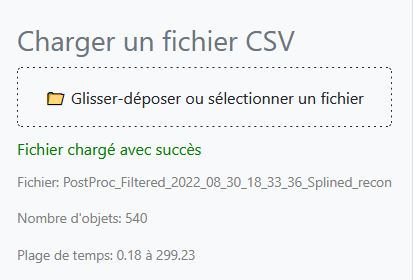General of moustic#
Description of the app moustic#
The application offers several advanced and interactive visualization features for mosquito swarms. Once the application is open, you can directly select a csv data file. This file must have the structure detailed in the "Requirements" section. This application is composed of three parts: - MosquiTrack for swarm visualization - Mosquit'Love for pair detection - Mosqu'Investigate for research on stereotypical behaviors before mating
Exigence#
To use this code, you need a CSV file in the following format:
-
object: an integer identifier representing an object tracked over time.
-
time: a decimal number representing the elapsed time in seconds.
-
XSplined: the object's position along the X-axis (horizontal coordinate), expressed as a decimal number.
-
YSplined: the object's position along the Y-axis (vertical coordinate), expressed as a decimal number.
-
ZSplined: the object's position along the Z-axis (depth or height), expressed as a decimal number.
-
VXSplined: the object's velocity along the X-axis, expressed as a decimal number.
-
VYSplined: the object's velocity along the Y-axis, expressed as a decimal number.
-
VZSplined: the object's velocity along the Z-axis, expressed as a decimal number.
Each row of the file therefore corresponds to the state of an object at a given moment, including its spatial position and velocity in all three dimensions.
Example (excerpt):
| object | time | XSplined | YSplined | ZSplined | VXSplined | VYSplined | VZSplined |
|---|---|---|---|---|---|---|---|
| 1 | 3.151 | 0.192 | -0.152 | -0.111 | 0.465 | -0.050 | 0.403 |
| 1 | 3.171 | 0.201 | -0153 | -0.103 | 0.470 | -0.044 | 0.396 |
select a csv data file#

Once you have selected the csv file in your local files, information about the structure of your file will appear. You can see its name, the number of objects/mosquitoes with a trajectory, and the time range entered in your csv files.